#Jean Louis Berthault
Text
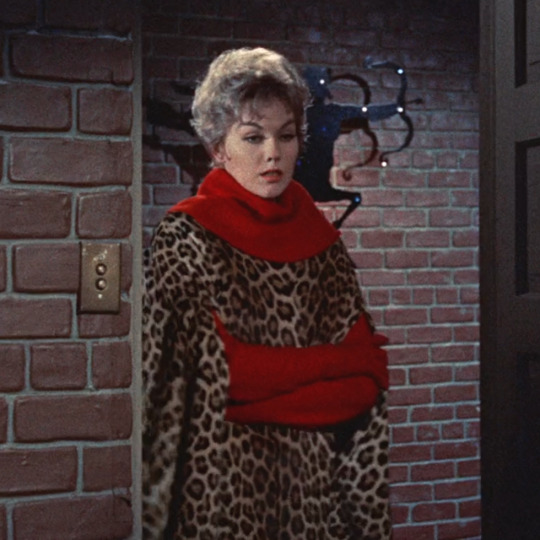


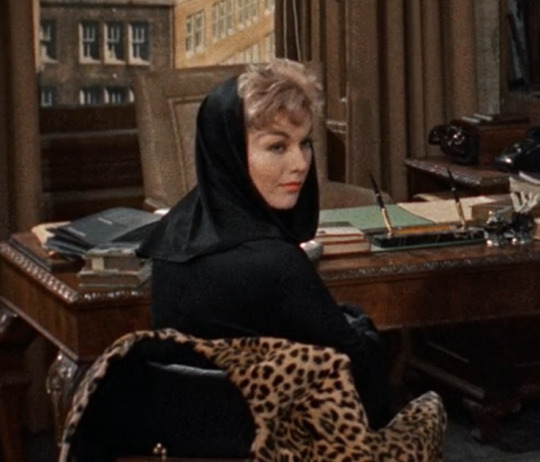

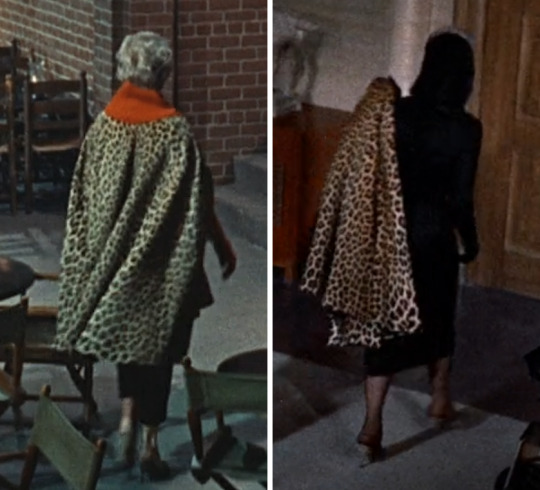
One Dress a Day Challenge
Anything Goes December
Bell, Book and Candle / Kim Novak as Gillian Holroyd
This reversible leopard-print cape is not only attractive, but symbolic. It's the first article of clothing we see Gillian wear that isn't black or red, and it appears right after she decides to accept Shep's proposal of marriage. It first appears with the leopard side out, over a brilliant red base, when she finds out her brother has been collaborating on a book that threatens to expose New York's magical community. Later, we see it with the leopard side in, over a black dress and hood, when she decides to tell Shep the truth. After that, her clothes return to black and red until the very last scene, when she appears in springy pastels.
The costume designer for this movie was Jean Louis (Berthault), who also designed Gilda and won an Academy award for The Solid Gold Cadillac.
#bell book and candle#anything goes december#kim novak#one dress a day challenge#one dress a week challenge#movie costumes#1950s style#1950s fashion#1958 movies#1958 films#gillian holroyd#50s fashion#50s style#jean louis#jean louis berthault
25 notes
·
View notes
Text
20 aprile … ricordiamo …
20 aprile … ricordiamo …
#semprevivineiricordi #nomidaricordare #personaggiimportanti #perfettamentechic
2022: Robert Morse, Robert Alan Morse, attore e cantante statunitense. E’ stato sposato due volte e ha avuto cinque figli. (n.1931)
2022: Hilda Bernard, Hilda Sarah Bernhardt, attrice argentina. È stata sposata due volte: con Horacio Zelada e con il regista Jorge Goncalvez. (n.1920)
2021: Tempest Storm, nata Annie Blanche Banks, è stata una ballerina e attrice statunitense di genere burlesque.…
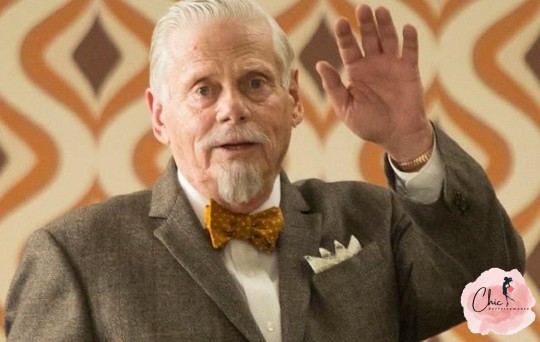
View On WordPress
#20 aprile#Alfred Hawthorn Hill#Annie Blanche Banks#Arthur Grant#Benny Hill#Bruno Persa#Doris Dawson#Flora Carabella#Galeazzo Benti#Galeazzo Bentivoglio#Glady Silvani Smith#Gladys Silvani Smith#Gladys Sylvani#Hilda Bernard#Hilda Sarah Bernhardt#Jean Louis#Jean Louis Berthault#Karl Hirenbach#Lady Duff Gordon#Lucile#Lucy Christiana Duff Gordon#Lucy Christiana Sutherland#Peter Lee Lawrence#Pierre Clement#Ricordiamo#Robert Alan Morse#Robert Morse#Tempest Storm#Tilly Newes#Tilly Wedekind
0 notes
Text
Kim Kardashian en robe Jean-Louis Berthault auparavant portée par Marylin Monroe sa valeur est de 4.81 M lors du 45e anniversaire du président John Fitzgerald Kennedy, lorsqu'elle lui déclara en chanson la célèbre phrase : « Happy Birthday, Mr. President »
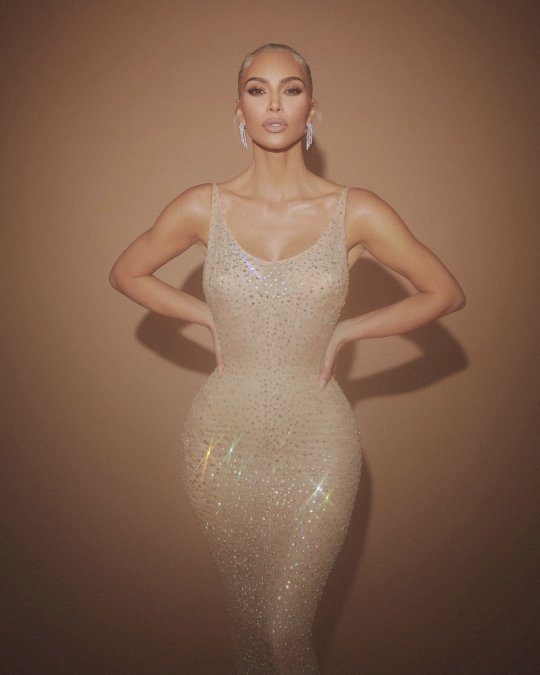
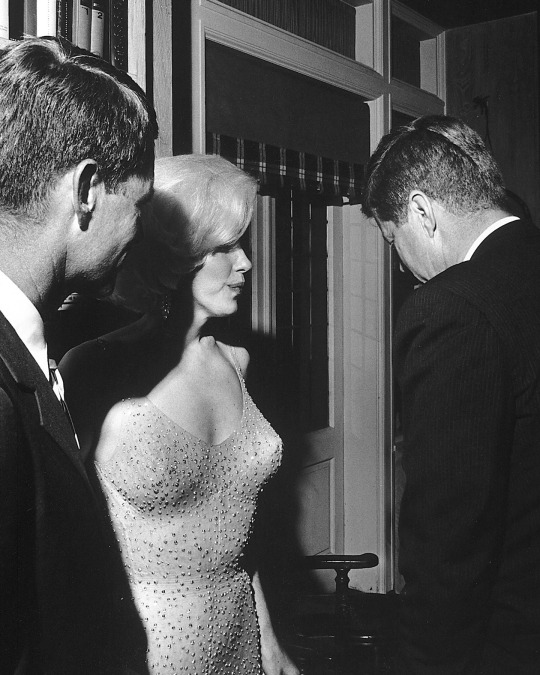
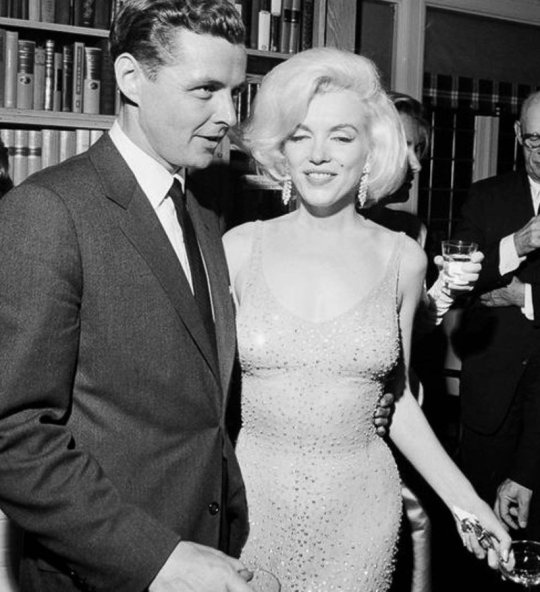
le Met Gala 2022 a eu lieu le lundi 2 mai au Metropolitan Museum of Art il a vibré au rythme des sars habillées pour l'occasion autour du thème In America: An Anthology of Fashion. Organisé par Anna Wintour
2 notes
·
View notes
Text
Bibliography
Primary Sources
Diary of Lucile Duplessis 7-9 July 1788. Found within Lejeune, P. On Diary. Honolulu: University of Hawaii Press, 2009.
Camille to Jean Benoît Nicolas Desmoulins, 24 December 1790. Found within Violet Methley, Camille Desmoulins; A Biography. London: Martin Secker, 1914.
Lucile Desmoulins to Louis-Marie Stanislas Freron, December 1793, found within Claretie, J. Camille Desmoulins and His Wife: Passages from the History of Dantonists Founded Upon New and Hithero Unpublished Documents. London: Smith, Elder and Company, 1876.
Memoirs of the Sansons edited by Henri Sanson: Late Executioner of the Court of Justice of Paris, 1688-1847, Robarts – University of Toronto, ark:/13960/t5r789j67.
Post 1: Lucile Desmoulins’ ‘Little Red Book’, 1771-1794, National Library of France, ark: / 12148 / bpt6k74578p.
Copyright: Florence Rochefort , " Lucile DESMOULINS, Journal 1788-1793 ", Clio. History, women and societies [Online], 4 | 1996, Online since 01 January 2005, connection on 28 September 2020. URL: http://journals.openedition.org/clio/452
Post 2: Rousseau, Jean-Jacques. Emile, or On Education. Geneva: unknown original publisher, 1762.
Post 3: Pierre-Gabriel Berthault and Jean-Louis Prieur, Motion made at the Royal Palace by Camille Desmoulins: July 12 1789, etching completed 1802.
Copyright: [Recueil. Collection Michel Hennin. Estampes relatives à l'Histoire de France. Tome 118, Pièces 10278-10385, période : 1789]. Identifier (FrPBN)41089369.
Post 4: National Library of France, Ego stultus propter Christum, 1790.
Copyright: Source gallica.bnf.fr / Bibliothèque nationale de France.
Post 5: Bibliotheque nationale de France, Les arcades du Café de Foy, 1790.
Copyright: Source gallica.bnf.fr / Bibliothèque nationale de France.
Post 6: National Library of France, Horrible attacks by Francois Comis in Paris on August 10, 1792, 1792.
Copyright: Source gallica.bnf.fr / Bibliothèque nationale de France.
Post 7: Camille Desmoulins, Le Vieux Cordelier, December 30, 1973.
Copyright: Source gallica.bnf.fr / Bibliothèque nationale de France.
Post 8: Camille Desmoulins to Lucile Desmoulins, March 1794, Papers of Camille Desmoulins, The British Museum 1948, 0214.377.
Copyright: The Trustees of the British Museum
Post 9: Jacques-Louis David, Portrait de Camille Desmoulins en famille, 1792.
Copyright: Photo RMN-Grand Palais
Secondary Sources
Abray, J. “Feminism in the French Revolution.” The American Historical Review, vol. 80, no. 1 (1975): 43-62.
Claretie, J. Camille Desmoulins and His Wife: Passages from the History of Dantonists Founded Upon New and Hithero Unpublished Documents. London: Smith, Elder and Company, 1876.
Darrow, M.H. “French Noblewomen and the New Domesticity, 1750-1850.” Feminist Studies, vol. 5, no. 1 (1979): 41-65.
Gliozzo, C.A. “The Philosophes and Religion: Intellectual Origins of the Dechristianization Movement in the French Revolution.” Church History, vol. 40, no. 3 (1971): 273-283.
Haine, S.W. The Word of the Paris Café: Sociability Among the French Working Class, 1789-1914. Baltimore: John Hopkins University Press, 1998.
Hammersley, R. “Camille Desmoulins’s Le Vieux Cordelier: a link between English and French republicanism.” History of European Ideas, vol. 27, no. 2 (2001): 115-132.
Kerber, L. “The Republican Mother: Women and the Enlightenment – An American Perspective.” American Quarterly, vol. 28, no. 2 (1976): 187-205.
Lefebvre, G. The French Revolution. London: Routledge, 1930.
Lejeune, P. On Diary. Honolulu: University of Hawaii Press, 2009.
Lusebrink, H-J and Reichardt, R. The Bastille: A History of a Symbol of Despotism and Freedom. Durham: Duke University Press, 1997.
McPhee, P. The French Revolution 1789-1799. New York: Oxford University Press, 2002.
Methley, V. Camille Desmoulins; A Biography. London: Martin Secker, 1914.
Scurr, R. Fatal Purity: Robespierre and the French Revolution. New York: Random House, 2012.
Sewell, W.H. “Historical events as transformations of structure: Inventing revolution at the Bastille.” Theory and Society, vol. 25, no. 6 (1996): 841-881.
4 notes
·
View notes
Text
Where do “Left” & “Right” come from?
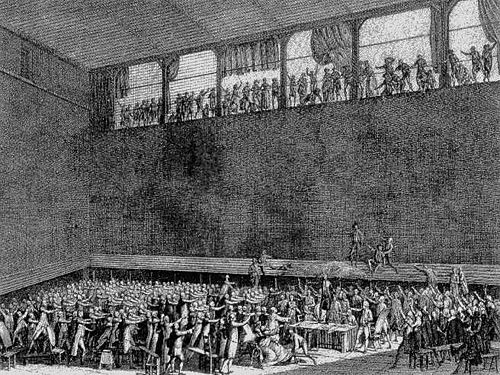
Le serment de Jeu de Paume. Copper plate by Pierre-Gabriel Berthault after a drawing by Jean-Louis Prieur (1789).
The terms "left" and "right" appeared during the French Revolution of 1789 with how the National Assembly divided supporters of the king vs supporters of the revolution.
This Assembly called themselves the "National Assembly" since they represented at least 96% of the nation. They took sovereign powers in respect of taxation and decided to frame a constitution restricting the powers of the king. Henceforth, sovereignty was to reside not in the person of the monarch but in the nation, which would exercize it through the representatives it elected. However, the Assembly considered itself to be acting in the king's interests and originally they declared all their laws subject to royal approval.
Following the storming of the Bastille on 14 July, the National Constituent Assembly became the effective government of France.
Relative to the viewpoint of the speaker (chair) of this assembly, to the right were seated nobility and more high-ranking religious leaders. To the left were seated commoners and less powerful clergy. The right-hand side (called le côté droit in French) became associated with more reactionary views (more pro-aristocracy) and the left-hand side (le côté gauche) with more radical views (more pro-middle class). Those with more moderate views were seated toward the center, while those with more extreme views were seated toward the edges.
1 note
·
View note
Link
First Edition Oblong folio (15' x 11') in black morocco leather-backed marbled boards with morocco corners. A collection of 53 engravings, the first two plates engraved by Niquet after Girardet and most of the others engraved by Berthault after Jean-Louis Prieur. Plate size is mostly 11' x 9' on slightly larger sheets. Minor and occasional foxing, mostly in the margins. Plates fresh and clean. Slight wear to the binding, the front joint partly split but the covers tight. Near Fine
0 notes
Link
A well-to-do western suburb of Paris, Courbevoie is in touch with the center of the city but has an easy, residential feel.
There are some understated museums to check out, housed in pavilions that were made for the Exposition Universelle in 1878. Courbevoie also contains some of La Défense, the city’s modern banking district, so you won’t have to go far for dynamic urban architecture and France’s number one shopping mall. And despite being in the suburbs, you’ll also have lightning-quick journey times to the center of Paris on the Métro Line 1. For the sake of convenience, we’ll deal with the things you can do in the west of Paris first. Discover the best things to do in Courbevoie.
[toc]
1. Musée Roybet Fould
A forgotten piece of Paris history, the site of this museum is a wooden pavilion built by Norway and Sweden for the University Exhibition in 1878. It’s a fusion of the old and new, because it’s in a traditional Scandinavian-style house, while also standing as an early piece of prefab architecture.
The permanent internal displays are mostly from the time that the stall was built. And as the museum’s name suggests these entail paintings by Ferdinand Roybet and Consuelo Fould.
On it, there are paintings and sculptures by Jean-Baptiste Carpeaux, and lots of small curiosities from the 19th century, such as toys, dolls, postcards, and posters.
2. Pavillon des Indes
Also from the University Exhibition in 1878 was Pavillon des Indes. This enchanting pavilion was actually commissioned by Edward VII, then Prince of Wales, to represent British India at the show.
As with the Musée Roybet Fould, it was originally placed on the Champ de Mars in front of the Military Academy.
Both were relocated to the Corbevoie Gian Parc de Bécon in the 1880s, where the Pavilion des Indes are still protected as a monumental monument. After falling into disrepair, the pavilion was restored in 2013 and reopened as a studio and gallery for emerging young artists, along with a small exhibition about Courbevoie in Tertiary. Republic.
3. Parc de Bécon
These pavilions decorate the peaceful Parc de Bécon, which slopes down to the left bank of the Seine.
And there are a few other things to keep in mind: You can see the front of the Charras Barracks, the site of the Swiss Guards, mercenaries protecting the King from the 17th century to the Revolution and the famous massacre at the Tuileries Palace.
You can also ponder the memorial to the National hero Maréchal Leclerc who died in a plane crash in 1947 and was posthumously awarded the title Marshal of France. There’s a dreamy view of the river from the monument’s terrace.
4. Folie Saint James
On the right bank of the Seine is an interesting small souvenir from Ancien Régime. He gave the architect permission to do whatever he wanted, provided it was expensive! And the outlandish result is a miniature mountain in the center of the garden with rocks that would have been transported here at a huge cost.
At the foot is a Doric temple and pond, and inside there used to be a network of tunnels covered with glimmering crystals.
5. La Défense
Many of the high-income residents of Courbevoie, making a short commute to the modern business district of Paris right next door. La Défense came to life in the 1960s and grew over the next 30 years, adding the sort of futuristic skyscrapers that wouldn’t get planning permission in the center of Paris.
New record-breaking structures are in the pipeline, but for now, it’s a district to wander and get some photos of the eccentric architecture and sculptures. If there’s an emblem for La Défense it’s the Grande Arche, a hollow cube-shaped building on an axis with the Arc de Triomphe several kilometers to the southeast.
6. Jardin d’Acclimatation
By car or subway, you've earned a few minutes to get to this attraction on the northern peak of Bois de Boulogne. This is music to children’s ears as they’ll be treated to rollercoasters, fairground rides, a miniature train, mini-golf, and animal attractions.
The Jardin d’Acclimatation was opened by Napoleon III in 1860 and still has a traditional air about it: There are landscaped gardens, many of the buildings go back to the 19th century and a lot of the entertainment is old-school and innocent, so think pony rides and puppet shows.
7. Fondation Louis Vuitton
Also on your doorstep is one of the newest cultural attractions in the city, and it’s pretty hard to miss. The museum was designed by Frank Gehry, and despite only being here since 2014 has recently been transformed.
The vaulting canopies suspended over the main structure of the building have been given a multicolored makeover by the French conceptual artist Daniel Buren. The collection inside is enriched by works from the big names in contemporary art, like Gilbert & George, Jean-Michel Basquiat, and Jeff Coons.
There are also installations by the likes of Olafur Eliasson and Ellsworth Kelly, as well as a permanent show about the project to construct this striking building.
8. Château de Malmaison
Although you’ll be instinctively looking towards Paris for sightseeing, there’s also lots to see on the western outskirts. If the traffic is quiet, you can reach this prominent Royal palace in about ten minutes.
For a time at the start of the 19th century, the château even shared the seat of the French government with the Tuileries, while it was Napoleon’s final residence before he went into exile after the 100 Days.
The woman who will forever be linked with Malmaison is Joséphine de Beauharnais, the first wife of Napoleon. She lived at this property from 1799 up to her death in 1814 and invested huge amounts of cash on its grounds and interiors. There is an inside museum with intimate personal effects by Joséphine and Napoleon.
9. Église Saint-Pierre-Saint-Paul
And since you’re in the area you could also call in at this church close to the château. It’s fine if sober Renaissance building, but the attraction isn’t so much how it looks but the events that took place here and the memorials inside.
Joséphine died of pneumonia in 1814 and her funeral took place on June 2 of that year. Famous architects, Louis-Martin Berthault and sculptor Pierre Cartello collaborated on her tomb.
You can also see the stunning mausoleum of her daughter Hortense, who was the mother of Napoleon III who ruled France in the Second Empire and commissioned this monument.
10. Local Markets
There are four markets in the Courbevoie area, trading five days a week. Two of these, Marché Villebois Mareuil and Marché Charras are covered, while Marché Marceau and Marché du Faubourg de l KhanArche are open air.
All have butchers, bakers, confectioners, fishmongers, florists, the cheese stands and sell traditional artisan products. And they’re local institutions, preferred to supermarkets for a couple of reasons: First, what you buy comes straight from the farm, cutting out the middleman and making it fresher.
But also, the traders selling this product are experts and will give you tips on how to store and cook whatever you buy from them.
More ideals for you: Top 10 things to do in Cosenza
From : https://wikitopx.com/travel/top-10-things-to-do-in-courbevoie-708263.html
1 note
·
View note
Text
20 aprile … ricordiamo …
20 aprile … ricordiamo …
#semprevivineiricordi #nomidaricordare #personaggiimportanti #perfettamentechic
2022: Robert Morse, Robert Alan Morse, attore e cantante statunitense. Morse è molto noto per le sue apparizioni teatrali in musical e spettacoli di Broadway. Il suo ruolo più conosciuto è quello del giovane imprenditore J. Pierre-Point Finch nella commedia teatrale How to Succeed in Business Without Really Try, in scena a Broadway dal 1961 al 1965, e nell’omonima riduzione cinematografica, Come…

View On WordPress
#20 aprile#Alfred Hawthorn Hill#Annie Blanche Banks#Arthur Grant#Benny Hill#Bruno Persa#Doris Dawson#Flora Carabella#Galeazzo Benti#Galeazzo Bentivoglio#Glady Silvani Smith#Gladys Silvani Smith#Gladys Sylvani#Hilda Bernard#Hilda Sarah Bernhardt#Jean Louis#Jean Louis Berthault#Karl Hirenbach#Lady Duff Gordon#Lucile#Lucy Christiana Duff Gordon#Lucy Christiana Sutherland#Peter Lee Lawrence#Pierre Clement#Ricordiamo#Robert Alan Morse#Robert Morse#Tempest Storm
0 notes
Text
20 aprile … ricordiamo …
20 aprile … ricordiamo …
#semprevivineiricordi #nomidaricordare #personaggiimportanti #perfettamentechic
1999: Flora Carabella, attrice teatrale e attrice cinematografica italiana. (n. 1926)
1997: Jean Louis, nato Jean Louis Berthault, è stato un costumista francese naturalizzato statunitense. Nato a Parigi lavorò come costumista dal 1944 al 1958 alla Columbia Pictures, per passare poi, dal 1959 al 1968, all’Universal Pictures. Prima di Hollywood, ha lavorato a New York per l’imprenditrice di moda…

View On WordPress
#20 aprile#Alfred Hawthorn Hill#Arthur Grant#Benny Hill#Bruno Persa#Doris Dawson#Enzo Jannace#Flora Carabella#Galeazzo Benti#Galeazzo Bentivoglio#Glady Silvani Smith#Gladys Silvani Smith#Gladys Sylvani#Jean Louis#Jean Louis Berthault#Karl Hirenbach#Lady Duff Gordon#Lucile#Lucy Christiana Duff Gordon#Lucy Christiana Sutherland#Peter Lee Lawrence#Pierre Clement#Ricordiamo
0 notes